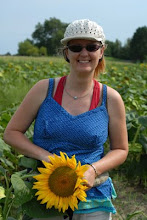It's winter, so time for some blog house keeping! And geese are on my mind, as I found out yesterday the reason why my gander Kristopher has been so paranoid in the run recently... the darn things started a nest! In January! While the temps are below single digits and worse! I ended up removing six frozen and cracked eggs and hope they'll either stop laying, or keep on laying in the same spot so I can keep an eye on it. I like them making the nest in the side run, as we can lock that up at night, but worry repeated egg harvesting might scare them off somewhere else...
Let's see, last time I posted we had received five goslings from my son's incubating program at school. The brooding goose managed to hatch another eight (!) which is our record. If I remember correctly there were only one or two unhatched eggs left in the nest. From talking to other goose and duck enthusiasts we deduced that the hatching rate last Spring was high because the average humidity was high; we had a lot of rain and drizzle (and mud).
Goose eggs need moisture to develop correctly which is why a lot of waterfowl need access to a pond for successful hatching; the brooders swim occasionally and thus bring back moisture to the nest by their damp breast feathers. We do have a large rubbermaid container for them to poodle in but don't really see brooding mommy make all that much use of it, she hangs around closer to home. But she is not on the nest at all times, so next season I plan to mist the eggs occasionally and see if that makes a difference. The previous year we had three goslings from 7+ eggs. That was an above average dry spring, so it would be great if we can increase their hatching rate with just a little spritzing!
All five school goslings ended up being adopted by the larger brood and within a month or so the whole group was walking around together. We sold three of the school goslings; since I kept a close eye on them as they lived in the sunroom I was able to see sex differences and tagged them accordingly. We kept a boy / girl couple ourselves and sold the others as breeders.
Two of the eight brooded goslings quickly got separated at night and died from exposure (they squeezed thru the run/side run wire partition but did not have the thinking to walk around to the door and loop back - I put a strip of smaller diameter fencing around the side run to prevent this from happening again), the other six made it to adulthood fine. We butchered those, for our and our friends' freezers. Feedback was that it tasted the best when deep fried, but then, what doesn't!
It was nice having a large group of geese strolling the yard and garden. It looked so homely (and apparently scared the wacky neighbors, another plus!). Even tho we had a bumper crop of fruit and apples this year we had hardly any problem of rotting fruit on the ground! I had already put a wood snow fence around the chicken yard for our fox problem, which in early season kept the fox out and in later season the ever hungry geese. We'd kick the geese out in morning, feed the chickens, and then let the geese back in at night - otherwise there'd be no feed left! We ended up not feeding the geese commercial feed for about 4 months, stimulating them to graze and gather for themselves as they grew to a respectable weight of about 6-8 pounds dressed - and apple & leftover marinated :)
Tuesday, January 28, 2014
Subscribe to:
Post Comments (Atom)








No comments:
Post a Comment